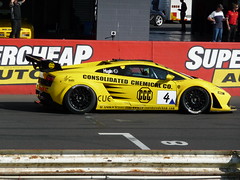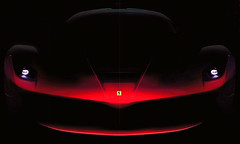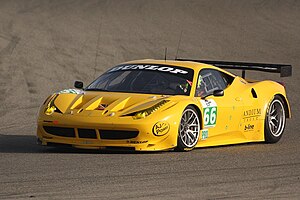- The Lancia Ecochic range is extended with the new Fashion City Car equipped with the 80HP 0.9 TwinAir Turbo bi-fuel Methane-Petrol.
- 86g/km CO2 emissions and consumption of 3.1kg/100km in the combined cycle.
- It takes less than 12 euros to fill up with methane.
- The total range with methane+petrol is more than 1,300 km over the extra-urban cycle.
- Available in the Silver and Gold trim levels, with list prices of 16,500 euros and 17,500 euros respectively.
- The 'open door' event dedicated to the new model will take place in January in Italy.
 |
| Lancia Ypsilon at the 2011 Geneva Motor Show. www.autoviva.com/lancia_lancia_ypsilon_gen_3/series/8618 (Photo credit: Wikipedia) |
From today, the Lancia Ypsilon Ecochic Methane can be ordered in Italy, the new minimal environmental imp
act version which combines the economic and environmental benefits of methane supply with the power and fun at the wheel guaranteed by the 0.9 Turbo TwinAir engine in a single product.
The new model is available with the Silver and Gold trim levels - list prices are 16,500 and 17,500 euros respectively - and in the first stage of the launch the Silver comes with free climate control, the Gold version with elegant 15" alloy wheels.
The standard equipment is highly attractive. It includes, from the first trim level and in addition to the climate control offered at launch, significant content such as ESC complete with ASR and Hill Holder, electric door mirrors, electric front windows, height and depth-adjustable steering wheel, 50/50 split rear seat, height-adjustable driver's seat, radio setup and fabric interior. The Gold trim level, in addition to the 15" alloy wheels offered at launch, features manual climate control, CD radio with MP3 player, leather trim on the steering wheel and gear lever gaiter, lumbar adjustment for the driver's seat, backrest pocket and Castiglio® upholstery.
A smart solution, especially in a period marked by constantly rising petrol and diesel prices, the new methane/petrol version achieves two important results. On one hand, it completes the offer of the Lancia's Fashion City Car, a model which encounters ever growing success both with the public and with critics, as demonstrated by the approximately 60,000 registrations from its launch to date.
On the other hand, the new car extends the current Ecochic range - comprising the Musa, Delta and Ypsilon models - able to combine the elegance typical of Lancia cars with the eco-friendliness and economical running of LPG/Petrol and CNG/Petrol fuel systems.
The Ecochic range is a prompt response to a constant demand which is also growing rapidly: in the first ten months of 2012, registrations of methane-powered cars in Italy increased by 43% compared to the previous year, while the percentage figure for LPG reached a record of 137%, in a market that - in the same period - saw a decline of 20%. The methane supply network is expanding constantly and now comprises more than 900 refuelling points in Italy.
In anticipation of the 'open door' event scheduled for 19 and 20 January at Lancia dealerships in Italy, the début of the new model will be accompanied by an advertising campaign on TV, the web, in print and on the radio.
Exclusive benefits, fully respecting the environment
The new methane Lancia Ypsilon Ecochic ensures reduced CO2 (86 g/km) emission levels and low fuel consumption (3.1 kg/100 km in the combined type-approval cycle) when running on methane. It should be noted that this vehicle's emissions are one of the lowest on the entire market. That's without mentioning that running on methane ensures costs per kilometre which are much lower than petrol versions, so much so that it is possible to cover double the mileage for the same fuel cost. What's more, thanks to the dual tank, the total range (methane+petrol) exceeds 1,300 km over the extra-urban cycle.
But the advantages of methane don't stop at fuel consumption. In some regions of Italy, cars with this fuel type are exempt from the payment of road tax for five years and - if the system is installed in the factory, as is the case for the models in Lancia's Ecochic range - throughout the car's lifetime. In fact, compared to an aftermarket conversion, a car with a factory-fitted system (OEM) offers other important advantages. For example, the use of specific materials and components and the application of dedicated technology, enabling the customer to benefit from a Lancia contractual warranty. Also, since the modifications to the chassis are carried out directly in the factory, the car can boast the highest standards of comfort and safety, as borne out by the numerous and stringent tests that the various system components are subjected to.
Finally, and in addition to the purely financial aspects, the increase in the number of methane-powered cars on the road is also allowing significant reductions in harmful atmospheric emissions, not forgetting that in many town centres, only "green" vehicles are permitted to travel. In fact, methane does not emit particulates, and its nitrogen oxide emissions are around 90 per cent lower than diesel, while compared to petrol, unburnt hydrocarbon levels are 75 per cent lower, nitrogen oxide emissions are around 50 per cent lower and CO2 emissions are reduced by 23 per cent. These are the reasons why methane-fuelled vehicles are given free access to town centres with traffic limitation restrictions in force for environmental reasons. To sum up, with less expense, less pollution and greater mobility, methane is becoming an ever cleaner and more economical fuel.
80 HP TwinAir Turbo Bi-Fuel: a heady mix of personality and environmental awareness
The new 80 HP 0.9 TwinAir Turbo Bi-Fuel is a turbocharged engine, fuelled by methane/petrol and full of personality, with a high specific power and torque, which perfectly blends reduced consumption with fun at the wheel.
Compared to the petrol version, the TwinAir methane includes specific fuel system components, including the intake manifold, injectors, electronic engine control system and valve seats with specific geometry made of low-wear material. The perfect integration of all components and state-of-the-art technology - such as the MultiAir system and the turbocharger - guarantee maximum reliability and ensure that performance and handling remain the same when running on methane.
In detail, the two fuel systems (methane and petrol) are reciprocally independent: in normal conditions, the engine runs on methane and is always only started on petrol, switching automatically and immediately to the other system. The engine only switches to petrol if the gas is about to run out. It is nevertheless always possible to switch from methane to petrol and back again as desired, by pressing a button on the dashboard. Furthermore, two methane tanks - containing about 12 kg, which corresponds to 72 litres at a pressure of 200 bar - are arranged under the floor to keep the luggage volume virtually unchanged (202 litres).
Finally, the tank size is the same as for the petrol version of the Ypsilon: a capacity of a good 40 litres. This means that the methane-powered Ypsilon Ecochic ensures maximum freedom of movement even when you aren't near one of the more than 900 methane pumps open to date.
The additional choice for a successful model
The methane Ypsilon Ecochic TwinAir is the additional choice for a model which encounters ever growing success both with the public and with critics, as demonstrated by the approximately 60,000 registrations from its launch to date. In the course of 2012, it was always among the best selling cars in the segment. The Ecochic LPG version contributed to the excellent sales results, reaching 50% of total Lancia Ypsilon sales.
Lancia's 'Fashion City-Car' keeps on charming with its character, its sophisticated style and its anti-conventional class. And below this refined exterior, marked "Made in Italy", lies all the substance of a car that boasts cutting-edge technology in the fields of engines and comfort, which not only delivers reduced emissions and fuel consumption - thanks to technologies such as TwinAir, MultiJet II and Start&Stop - but also offers benchmark comfort thanks to highly valuable content.
Suffice it to say that it is the first and only car in the segment to offer an exclusive combination of the new "Blue&Me-TomTom LIVE" and "Smart fuel" system, in addition to the innovative second-generation Magic Parking, 500 W 360° Hi-Fi Music system, Xenon headlights and LED rear lights. It also holds its own in terms of safety, offering 4 airbags, Isofix attachments and ESC system (starting from the Silver trim level on methane, from the Gold trim level on other engine versions) as standard. These are precisely the features that customers most appreciate currently when using the new Lancia Ypsilon on a daily basis, the same qualities which have led it to be awarded prestigious prizes by the public and influential panels made up of specialist journalists.
Today the Ypsilon range comprises 3 trim levels (Silver, Gold and Platinum; the latter is not available on the methane version), 5 engine versions (69 HP 1.2 Fire EVO II, 69 HP 1.2 Fire EVO II LPG, 85 HP 0.9 TwinAir, 95 HP turbo diesel 1.3 MultiJet II and the new 80 HP 0.9 TwinAir methane), two gearboxes (manual and robotised), 17 body colours (including 5 two-tone), 3 interiors (fabric, Castiglio and leather), 3 alloy wheels (15" diamond-finish, 16" diamond-finish, 16" burnished diamond-finish).





















